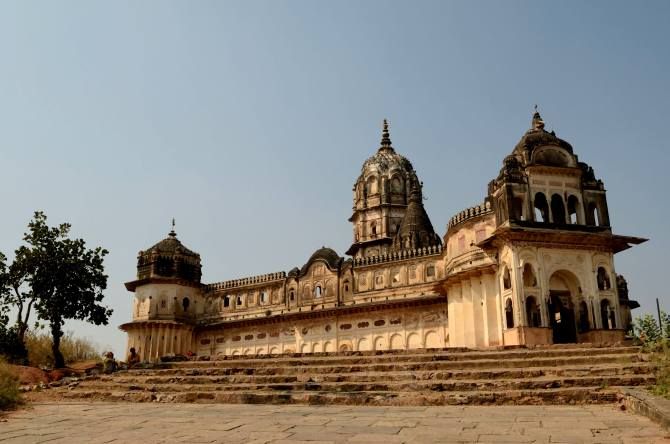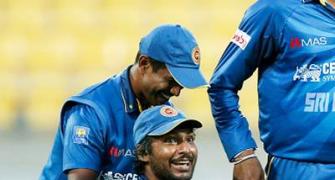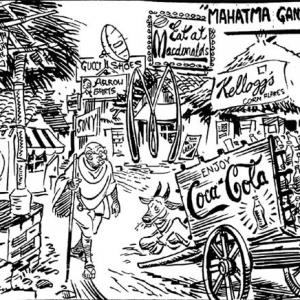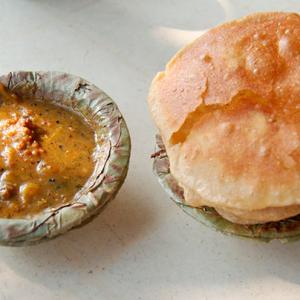Orchha in Madhya Pradesh is among the many, many places in India where history comes alive. Lakshmi Sharath recollects her recent visit to the former princely state in Bundelkhand.

You don't get often to stay in a palace, but here I am sleeping in one of the rooms, which was built in the 16th century by a prince for his friend. The friend was no other than the Mughal emperor Jehangir and the palace, named after him, was built in Orchha by the Bundelkhand Raja Bir Singh Judeo. I land here by chance.
The rooms in the neighbouring Sheesh Mahal are full and the hotel staff gives me a humble little corner in Jehangir Mahal. It does not matter. Just walking outside the palace in the open and watching the moon rise against a starry sky is sheer bliss.
However as morning dawns, the beauty of Orchha stands out in front of me like a pretty maiden who has just unveiled her face. Standing from the terrace of the Jehangir Mahal, I can see the entire "monumentscape" of Orchha framed against the dawn with the mist gently hovering over them.

Beyond the terrace of the Raj Mahal, is the towering Chaturbhuj temple with the Ram Raj Mandir adjacent to it. And in the distant horizon, stands the Laxmi Narayan temple, hardly visible in the mist. The city however is silent, wrapped in a hazy sheet of white, orange and yellow.

I walk up towards the River Betwa to catch the morning rays of sun caress the cenotaphs of the Bundelkhand kings. The vultures distract me but I am just lost in the moment. But Orchha founded by Bundela Rajpur chieftain Rudra Pratap is not a landscape of monuments. It is a town where the walls speak stories, where paintings reveal a culture, where tales of friendship, romance, betrayal, mysticism and sacrifice echo from every monument.
Intriguing, funny, unbelievable and irresistible these stories breathe life into these ancient mahals and mandirs, some of them still in ruins.
The most common story you hear in Orchha is the story of Jehangir Mahal, a palace that stands for friendship.

Once a bitter enemy of the Mughals, Raja Bir Singh Judeo helped Jehangir fight Abul Fazil who was sent by Akbar to kill his son. He gifted Jehangir with Abul Fazil's head as a sign of loyalty. Moved by his gesture, Jehangir returned Bundelkhand to Raja Bir Singh Judeo and crowned him the king. The Bundela king in turn built this palace to commemorate Jehangir's visit to Orchha, but it is believed that the Mughal king stayed here for just one night.
Pottering around the town, I visit the near by Raj Mahal, an art gallery lost to the world. The paintings here make the palace come alive. I walk a bit further to the Lakshmi Narayan Temple where the murals showcase the valour of Jhansi Ki Rani, Lakshmi Bai, a town which is barely a few kilometres away.
Stories are everywhere. But the tale that fascinates me the most is the tale behind a melancholic yellow palace which is now morphed into a bazaar. This was the palace of Dinman Hardol, the brother of one of the kings, Raja Jhujjar. Next to the derelict palace is a small temple. "Woh Hamara Bhagwan hai," says a local lady. I peer inside the shrine and realise that they worship Hardol, the prince who they believe is very much alive.
Hardol, the popular prince was resented by Jhujjar who further suspected his wife of having an illicit relationship with him. Fuelled by rumours spread by Emperor Shah Jahan, Jhujjar ordered his wife to poison Hardol to prove her innocence and Hardol willingly accepted it. The story doesn't end here. When Jhujjar's niece was getting married, his sister asked the king to help; who sarcastically asked her to seek the dead Hardol. The dead prince apparently attended the wedding and served the guests as well. The local exclaimed that even today it is believed that Lala Hardol attends weddings he is invited to and most locals leave an invitation card for him and seek his blessings as well.
"Woh Kabhi Bhi Zinda ho sakta hai," said the lady with a grim look, almost chastising me for not believing them.
With stories of Jehangir and Shah Jahan in the air, I am waiting for a tale that would tell me a bit about Akbar. And I am not let down.
A small mahal here is dedicated to the courtesan, Rai Praveen who was passionately in love with her Bundelkhand king, Indramani. But Akbar wanted her in his harem against the wishes of the Bundelkhand king. The witty courtesan spoke her way out of Akbar's heart who sent her back to Orchha. She apparently thwarted the Mughal emperor saying "only a royal servant or a crow or a dog will like to eat something that has already been tasted and polluted by another."
My last stop is the Ram Raja Temple, where I stop by to see the Aarti. There are many legends around the temple. Stories of Lord Ram visiting the queen in her dreams and asking her to build a temple for him are the most common ones. The legend goes that while the king Madhukar Shah was a devotee of Krishna, his wife was an ardent devotee of Ram. The clash in devotion and deities apparently created a rift between the couple. The king demanded that the queen return from her pilgrimage to Ayodhya, with her deity in tow, but in the form of a boy. Faced with a choice of never being able to return to Orchha again, the queen fervently prayed to her God.
Her ardent prayers apparently pleased Lord Ram that he agreed to come back to Orchha with her in the form of a boy, but on a condition -- he will not move from one temple to another, but will stay where she initially houses him. The sight of Ram as a child pleased the king that he agreed to build a temple for him, while the deity was worshipped by the queen in her palace. When the temple was eventually ready, the deity refused to move but remained in the queen's palace which eventually became the Ram Raja Temple.
Ram is worshipped not just as a God, but as a king as well and his temple resembles a palace. And the temple built by the king was the adjoining Chaturbhuj temple which towers around the monument.
Photographs: Lakshmi Sharath









